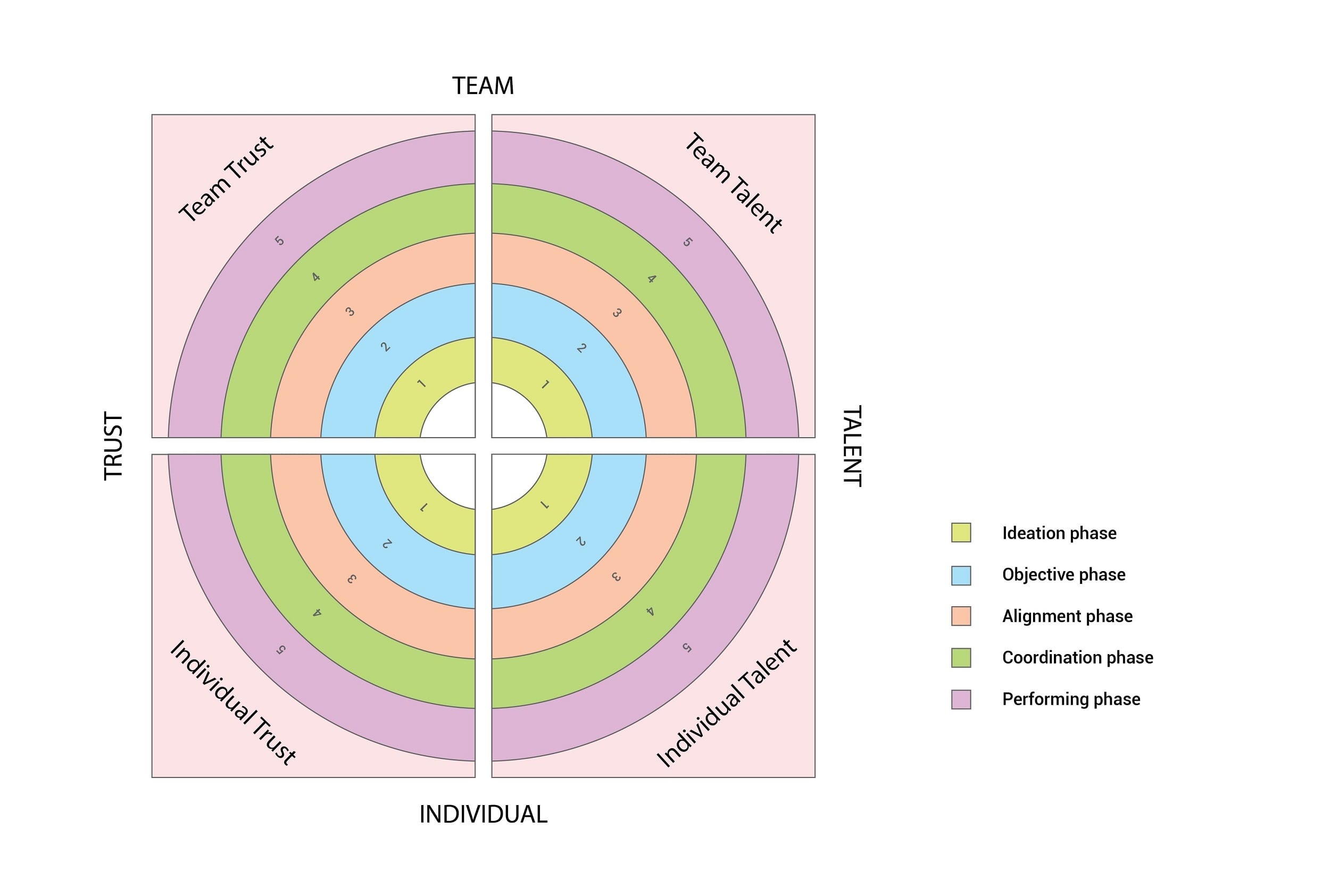“A talented team is any day better than a group of talented people. And a trusted team is more talented than a group of individual experts”
Of the myriad combination of factors that can be a formula for successful teams, Trust and Talent are the two most critical ones in my experience. With the right alignment to individuals and teams, these factors can drive the growth to achieve high-performance teams. As someone passionate about team development, I looked back at some commonalities across all the high-performance teams that I was a part of, and realized that stitching together four quadrants (namely, Team-Trust-Individual-Talent) in a circle as shown below in five-phases, leads to the ultimate nirvana of a team’s talent and performance. Balancing growth through each phase, across all four quadrants is key to forming the perfect circle of realization.
In reference to the picture below, the four quadrants can be classified as:
| Quadrant | Description |
|---|---|
| Team, Trust | The trust in the team is represented in upper left quadrant |
| Team, Talent | Talent of the team is represented in the upper right quadrant |
| Individual, Trust | An individual’s trust in the team and work is represented in the lower left quadrant |
| Individual, Talent | An individual’s talent is represented in the lower right quadrant |

And the five phases of growth are:
| Phase | Description |
|---|---|
| Ideation phase | This phase is about ideas on the concept/product that the team is constituted for |
| Objective phase | This phase is about building the vision for the product/work that the team ultimately would share and work towards |
| Alignment phase | Assignment of roles and identification of the work products constitute this phase |
| Coordination phase | In this phase coordination between various work products leading to realizing the vision should be shaping up |
| Performing phase | This phase is about product reviews, and the team in action |
The quadrants stay in equilibrium only when each sector of the circle connects perfectly with its corresponding one in other quadrants. In essence, a phase 1 in one quadrant cannot match to phase 2 of other quadrants to form a perfect circle.
At each phase, a match of trust and talent with individuals and teams, generates an eco-system that fosters further growth into the next phase.
As an example, individuals however talented they might be, if they cannot trust the ideations, then probably they will hamper the growth to the next phase.
Teams that do not trust the objectives, however talented they might be, will lag behind for the next phase.
A combination of Highs, Lows of talent and trust indicate an interesting pattern of biases for further analysis.
A high trust-high talent scenario leads to a Bias for action: This is the most ideal bias to have. Talent manifests itself unequivocally in the context of high trust and lead to Team Nirvana.
A high trust-low talent scenario could indicate an in-group Bias: A compelling need for familiarity values the immediate group of people more than unfamiliar people. A higher trust of in-group which does not match with higher talent, can be a hindrance to building real talent into the teams. Most often complacent, less challenged, loyal & committed teams score high on trust. They need to be pushed to the edges to be able to re-discover / grow their talent.
A low trust-high talent scenario can lead to a bias against risk: Continuous challenge to prove their worth combined with risk aversion impacts talent. A routine with zero-risk and zero-innovation would become the highest preference, thus risking creativity. A small dose of risk is healthy to keep the scale of talent higher and performance excellent, and an appetite for risk depends on the amount of trust that can be put in. Higher the trust, more the appetite for risk is likely to get.
A low trust-low talent scenario could lead to a bias for Prima Donnas: With low trust and low talent of the team, the onus of bringing success is highly dependent upon Prima Donnas that can burn midnight oil. A repeat of success may not be guaranteed. However, Prima Donnas could be discovered repeatedly that can possibly manage to keep the organization afloat.
Pattern of biases summarized:
| Team Nirvana | In-group bias | Bias against risk | Prima Donnas | |
|---|---|---|---|---|
| Team Trust | High | High | Low | Low |
| Individual Trust | High | High | Low | Low |
| Team Talent | High | Low | High | Low |
| Individual Talent | High | Low | High | High |
In conclusion, Trust and Talent aligned well with Individuals and Teams can work wonders in building high-performance teams, and will lead to a true Team Nirvana.




